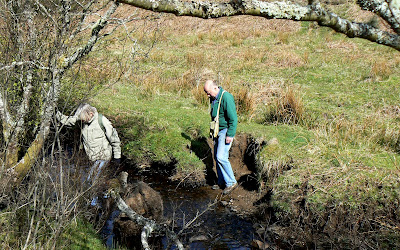 We had hardly left the road on our walk up Beinn na h-Urchrach yesterday before we saw the first deer, two red deer stags one of which had already lost his antlers.
We had hardly left the road on our walk up Beinn na h-Urchrach yesterday before we saw the first deer, two red deer stags one of which had already lost his antlers. Throughout the rest of the walk we saw groups of red deer, this one, which had been grazing on the saddle between Beinn na h-Urchrach and Ben Hiant, consisting of over twenty animals. We were out early on the hill, which probably explained why we saw so many. The area is very open but there is plenty of forestry for them to retreat to during the day.
Throughout the rest of the walk we saw groups of red deer, this one, which had been grazing on the saddle between Beinn na h-Urchrach and Ben Hiant, consisting of over twenty animals. We were out early on the hill, which probably explained why we saw so many. The area is very open but there is plenty of forestry for them to retreat to during the day. We found this corpse of a young deer lying in a burn under a small cliff. Judging by how little had been eaten, the state of the flesh, and the excitement of the local flies, it had not been there long.
We found this corpse of a young deer lying in a burn under a small cliff. Judging by how little had been eaten, the state of the flesh, and the excitement of the local flies, it had not been there long. At about the same time we caught a glimpse of an eagle. Unlike The Raptor, we are still learning how to identify eagles with any sense of certainty, but we think it was a golden eagle. It was being chased by a crow, but it seemed to turn away when it saw us: perhaps it had spotted the dead deer, but was put off by our arrival.
At about the same time we caught a glimpse of an eagle. Unlike The Raptor, we are still learning how to identify eagles with any sense of certainty, but we think it was a golden eagle. It was being chased by a crow, but it seemed to turn away when it saw us: perhaps it had spotted the dead deer, but was put off by our arrival. On the way back to the car we came across two fallow deer grazing on the edge of the forestry. Neither seemed particularly bothered by our approach: the only reaction from this one was to urinate.
On the way back to the car we came across two fallow deer grazing on the edge of the forestry. Neither seemed particularly bothered by our approach: the only reaction from this one was to urinate.These are the first fallow deer we've seen on Ardnamurchan Estate land, though The Diary is informed that they were introduced some months ago, so there are now four types to be seen - red, fallow, muntjac and roe.
To add to the pleasures of the day, we'd only been home a short time before we saw a sea eagle fly along the length of Ormsaigbeg. There was no mistaking the identification of this character: it was huge, and flying with the characteristic slow, heavy wingbeat of the species.
A map of the area of our walk is here.













































